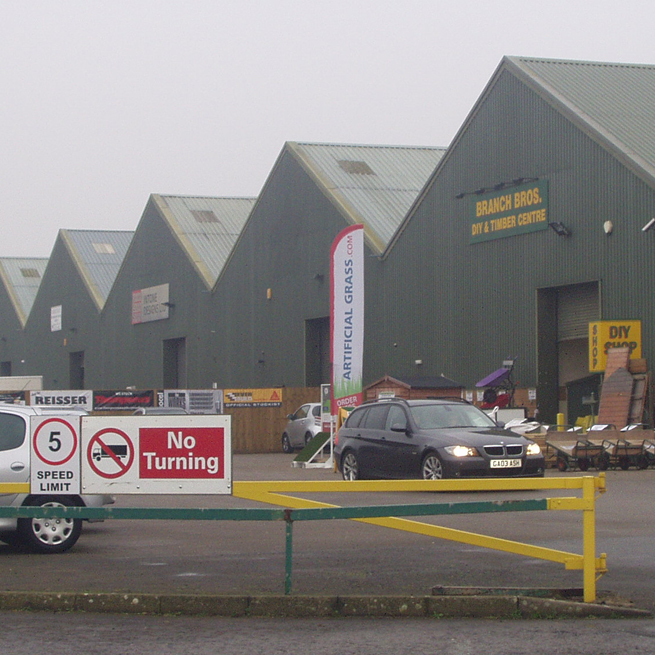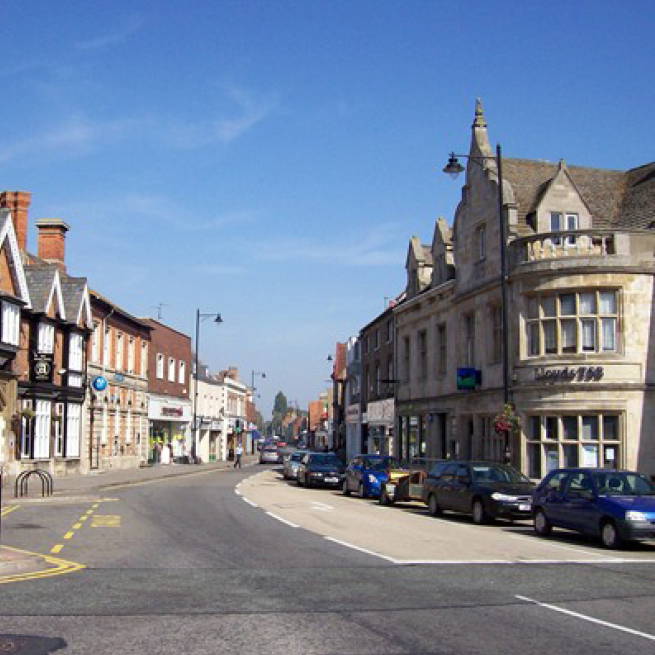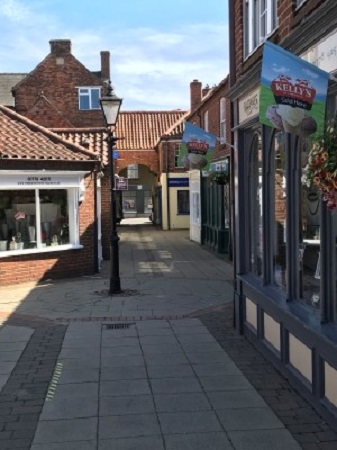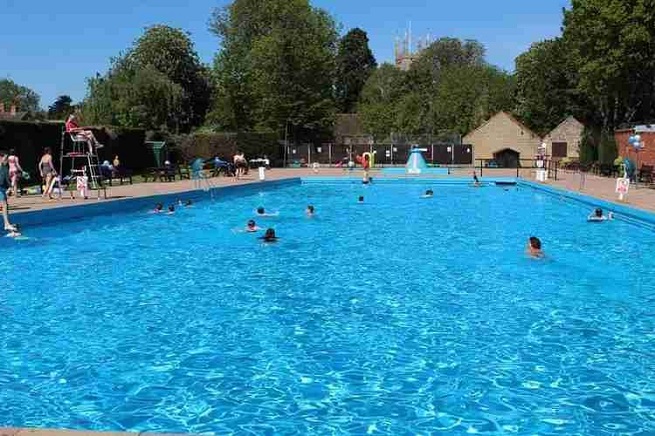Building a prosperous economy
Draft Objectives
Building A Prosperous Economy
Draft Objective NE1
To support the provision of employment opportunities in Bourne.
Draft objective NE2
To support uses and proposals that enhance the economic vitality and viability of Bourne town centre.
Draft objective NE3
To support the visitor economy whilst protecting the unique culture, environment and heritage of Bourne.
Employment
The employment estates in Bourne are clustered to the east of the town, although the town centre and buildings within the wider Neighbourhood Area also provide employment.
In recent years, housing development has dominated the growth of the town. To make Bourne a more sustainable community there is therefore a need to reduce out-commuting and redress the balance between housing development and employment opportunities.
The Local Plan safeguards the Pinfold Industrial Estate and existing employment areas on Cherry Holt Road for employment uses. It also includes a policy to retain and enhance other employment sites unless, for example, the site is no longer viable or there is an existing conflict between land uses.
The Local Plan also allocates 3 sites for employment purposes – land south of Spalding Road, east of the junction of Borne Eau/Car Dyke and land at Elsea Park.
The 2015 South Kesteven Employment Land Study (ELS) concluded that the sites on Cherry Holt Road have good/very good access to the strategic road network but poor access to public transport. These sites are generally in either very good or good condition with the majority of units occupied at the time of the survey. However, while the Pinfold Industrial Estate has good/very good access to the strategic road network it also has poor access to public transport with the site assessed as being in either poor or very poor condition.
The ELS indicates that over 98% of employment in South Kesteven is in either small (10 to 49 people) or micro (less than 10 people) businesses with almost 89% being in micro businesses.
The study also identified some signs of a low-wage economy and a disparity between the occupation of residents and the employment available within the district i.e. office based jobs are under-represented in comparison to the East Midlands average with many residents employed in management, professional and technical professions commuting outside the district to work in Peterborough and other locations.
While there are no recent travel to work figures for Bourne, the 2011 Census indicates that about one third of the working population travelled more than 10kms (6 miles).
The office market is quite small in South Kesteven with the majority of floorspace being in Grantham. Further growth is planned for at Grantham although some demand for smaller units in Bourne and other towns is likely. The ELS indicates that the proposed business park at Elsea Park would be an appropriate location for office development.
In 2011 approximately 10% of the working population of Bourne worked at or mainly from home. Improvements in information technology and changes in working patterns mean that there are increasing opportunities for home working.
The Town Centre
The Local Plan establishes the boundary of the town centre (shaded in green in the map, below) and defines both ‘primary’ and ‘secondary’ shopping frontages. The town centre is defined by the blue hatched area on the map below while the primary shopping frontages are edged in purple and the secondary frontages are edged in pink.
Shops are encouraged along the primary frontage (shown by the blue line in the map below) as well as other ‘A’ class uses such as restaurants, bars and cafes where they positively contribute to the town centre. Within the secondary frontage (shown by the pink line in the map), proposals for complementary uses will be supported. These include uses which can support the vitality of the town centre such as residential, employment, office, commercial, leisure/entertainment, healthcare and educational development.
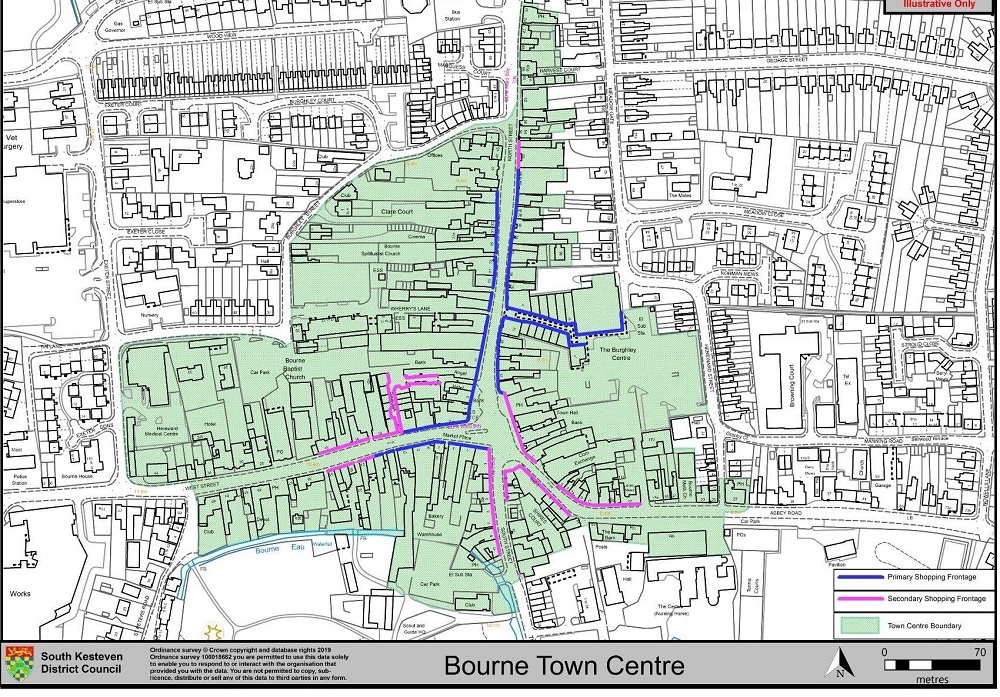
Nationally there have been significant changes in town-centre shopping areas for various reasons including changes in people’s shopping habits (for example, the rise of internet shopping and people buying goods from out-of-town retail parks) and in the physical form of shopping areas (for example, the loss of high street banks, an increase in coffee shops and food outlets and legislation enabling shops in some circumstances to be converted to residential development without the need for planning permission).
The town centre serves the daily shopping and service needs of local residents of the town and surrounding villages. However, it has come under threat from edge of town stores, online shopping and its close proximity to larger centres such as Grantham, Peterborough and Stamford.
There is a small market held every Thursday in the car park to the rear of the Corn Exchange building and a smaller market on a Saturday. There have been moves to bring the market back into the Market Place where it had always traditionally been held. However, not unlike the market in many other towns, the number of stall holders has been declining.
There are several pedestrianised parts of the town centre including the Burghley Centre, Wherry’s Lane, Crown Walk and Angel Walk.
A retail study undertaken on behalf of SKDC indicated that in 2015:
- 6.9% (9 units) of shop units were vacant – a figure considerably below the national average (it is thought likely that the vacancy rate has increased since that time, although it has not been possible to undertake a survey due to the pandemic);
- The centre is dominated by small, independent retailers;
- Food retailers accounted for about 5% of shops while comparison retail uses occupied 35% of units. Cafe and restaurants dominated the service outlets which at 48% of units was approximately 10.9% above the UK national average;
- Pavements and highways are relatively narrow;
- The general appearance of the town centre was reasonably good although the majority of shop frontages have a relatively dated appearance; and
- There is a strong reliance on the car to access the town centre and car parking spaces can be limited.
56% of respondents to the residents’ survey (2016) indicated that they did not want parking time restrictions on car parks within the town centre.
Over 80% of respondents to the survey would like to see a wider range of shops, including more clothes shops. There are no large national comparison retail shops in the town centre.
There are three main stores outside the town centre comprising Sainsbury’s in Exeter St, Tesco’s at Cherry Holt Rd and a Lidl store at South Road/Elsea Park. There is also a Tesco Express with petrol filling station at the junction of North Street and St Gilbert’s Rd. 59% of survey respondents believe that further out-of-centre retail development would not be good for the town.
Priority within the town centre is given to the car rather than pedestrians, cyclists and public transport. However, there are no proposals to construct a bypass to reduce the volume of traffic passing through Bourne on the A15. Consequently, opportunities to improve the environmental quality of the town centre are likely to be very limited.
Much of the town centre is within the Conservation Area which provides for greater control over the quality of new development. There are also a number of listed buildings – see the section on ‘Heritage’.
Some of the changes that could improve the vitality and viability of the town centre are matters that are outside the scope of land-use policy, for instance, improvements to markets, business rates and rents.
Tourism
Invest SK is South Kesteven’s economic growth and regeneration company. Data provided by Invest SK indicates that the total number of visits to South Kesteven increased by 11.5% between 2013 and 2018. Whilst most visitors come for the day (88.5%) there was a 5% increase between 2017 and 2018 in the number of overnight visits.
Invest SK considers the advantage and strength of Bourne to be its location as a touring base; the challenge is to encourage visitors to stay in and around Bourne, not just as day visitors passing through or attending an event.
Tourism can help the local economy to thrive; it can provide job opportunities and add vitality to the local area, including the town centre. 90% of respondents to the 2016 survey wanted Bourne to develop its tourism industry.
In 2018 shopping and food and drink accounted for 63% of visitor expenditure in South Kesteven. The attraction of the town of Bourne as a shopping venue and easy place to stop for refreshments is perceived as an attraction to visitors.
Bourne has a rich heritage with links, for example, to Robert Manning, who helped develop the English language; Hereward the Wake, the leader of resistance to the Norman Conquest; Charles Worth, founder of the Paris Fashion House, who was born at Wake House; and more recently, Raymond Mays who was behind the development of ERA and BRM which put Britain at the centre of the motor racing world. There are over 70 listed buildings in the parish and a local heritage centre at Baldock Mill.
There are a number of other attractions including Bourne Wood (visited by an estimated 100,000 people each year); the open air swimming pool in the Abbey Lawns; the former Corn Exchange which provides a venue for films, concerts, art exhibitions and plays; and the Delaine bus museum. Other local attractions outside the Parish include Grimsthorpe Castle, Park and Gardens, approximately 4 miles from Bourne.
There are several annual events held in Bourne which attract visitors and the local community. These include the Bourne Classic Car and Bike Show, The Bourne Festival and the Bourne Beer Festival.
A majority (73%) of respondents to the 2016 questionnaire thought that there was potential to develop the visitor economy. Suggestions include developing the town’s link to Charles Worth by staging a fashion festival; a permanent museum to Raymond Mays; developing and publicising footpath routes of varying lengths and themes; town centre improvements (see town centre section); and additional accommodation, including a high-quality caravan park. Bourne Civic Society has proposed a Bourne Heritage Experience, a circuit comprising the Red Hall, the Old Grammar School and Bourne Abbey Church as part of its proposal for restoration of the Old Grammar School.
Invest SK has limited accommodation listed for Bourne and has suggested that, prior to the pandemic, there was a need for good quality guesthouse accommodation in the town. There is anecdotal evidence that some clients visiting businesses in Bourne head to other towns to stay overnight.
The Local Plan provides support for development which is appropriate in use and character to its locality; enhances existing facilities or makes new provision; or provides/enhances tourist accommodation. Uses generating high volumes of traffic or increased public use of tourist facilities should only be permitted on the edge of the larger settlements or where they can be easily accessed by public transport, foot and cycle.

Supported By Bourne Town Council
Contact
Bourne Town Council
SK Community Point
3 Abbey Rd
Bourne
PE10 9EF
enquiries@bournetowncouncil.gov.uk

